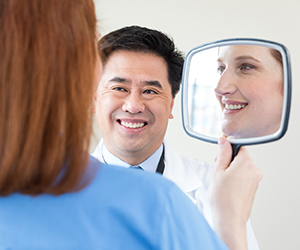Adult Acne
Adult acne is acne in people over the age of 25. Acne in teens is more common in boys. Acne in adults is more common in women.
Acne is the term for clogged pores. Pores are tiny openings on the skin. They may become inflamed and form blemishes. Adult acne shows up mainly on the face. In women, it forms around the chin, mouth, jawline, and neck. In men, acne often affects the entire face. But the trunk and upper arms can also have acne.
Acne can be treated. Treatments can help with the scarring and changes to skin color caused by acne.
What causes acne?
Male hormones may cause acne in some people. For example, this may happen in people with polycystic ovary syndrome (PCOS). Acne in women may happen due to changing hormone levels. This may happen before their menstrual periods, from menopause, or when starting or stopping birth control pills. Stress, hair and skin care products, or medicine side effects may also cause acne. You may be at more risk if you had acne when you were a teenager or if others in your family have had acne.
Types of acne
Acne happens when certain hair follicles are damaged. One or more things happen:
-
The hair follicle is blocked by dead cells and oil.
-
The follicle makes more oil than normal.
-
Bacteria grow in the follicle.
-
The follicle becomes irritated.
Four types of blemishes can appear:
-
Whiteheads are round, white blemishes. They form when hair follicles become clogged.
-
Blackheads are round, dark blemishes. They form when whiteheads reach the skin’s surface and touch air.
-
Pimples are red, swollen bumps. They form when a plugged follicle breaks open near the skin’s surface.
-
Deep cysts are pus-filled pimples. They form when plugged follicles break deep inside the skin. Acne cysts are often large and painful. In some cases, they also cause scars.
How treatment can help
Treatment can keep new acne blemishes from forming. It can also prevent scarring and changes in skin color. You will usually need a combination of treatments. You may need to use a treatment for at least 2 months to see if it works. This is because acne lesions take at least 8 weeks to develop.

Your treatment will depend on how serious your acne is. You and your healthcare provider can discuss the best way to treat and control it. In most cases, acne treatment includes:
-
Good skin care that doesn’t damage or irritate skin.
-
Medicines put on the skin (topical).
-
Antibiotics, hormones, or both.
Often you will need to take several medicines at first. For some treatments, women must use a birth control method so they won’t get pregnant while being treated.
Your healthcare provider may also remove blemishes or give you injections. If you have acne scars, you may need surgery or medicines to help improve the way your skin looks. Be sure you understand your treatment plan and any side effects it might cause. You will play an important role in the success of your treatment.